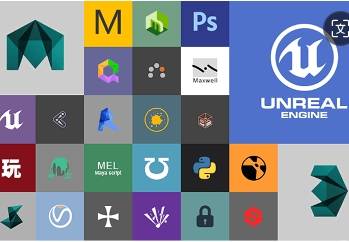Release date:2018, June 8
Duration:01 h 31 m
Author:Emily Holden
Skill level:Intermediate
Language:English
Exercise files:Yes
Medical animations indulge our curiosity about the human body by allowing us to peer within at key biological processes and anatomy. They are valuable communication tools for teaching healthcare professionals, trainees, and the general public about the wonders of the human body. In this course, learn about the basic principles and techniques of 3D medical animation using Autodesk Maya 2018. Discover where to find good resources and references, how to use the Protein Data Bank to download 3D models for molecular animation, and how to approach storyboarding. Learn how to create some basic medical animations, including cell division and blood cell flow. Plus, explore common visual aesthetics in medical animations and see how to use lighting and material shading to make your animations stand out.
Introduction
3D animating the hidden world of human anatomy 1m.25s.
What you should know 39s.
1. What Is Medical Animation?Why study medical animation? 2m.36s.
Finding the best references 2m.40s.
Protein Data Bank and Chimera 3m.16s.
Storyboarding your medical animation 1m.54s.
2. Basic Medical AnimationsIntroduction to animation projects 17s.
Commonly used tools: MASH 1m.55s.
Commonly used tools: nCloth and nParticles 1m.25s.
Commonly used tools: Paint effects 3m.30s.
Commonly used tools: Blend shapes 3m.29s.
Animating cell division, part 1 4m.3s.
Animating cell division, part 2 4m.16s.
Animating cell death, part 1 4m.33s.
Animating cell death, part 2 3m.48s.
Animating tumor growth, part 1 5m.16s.
Animating tumor growth, part 2 8m.21s.
Animating blood cell flow, part 1 5m.13s.
Animating blood cell flow, part 2 5m.54s.
3. Visual ImpactAesthetics in medical animation 46s.
Three-point lighting 5m.11s.
Cinematic lighting 5m.2s.
Working with layered shaders 7m.6s.
Working with shader subsurface scattering 3m.
Working with shader transparency 4m.32s.
Conclusion Next steps 1m.14s.001 3D animating the hidden world of human anatomy 002 What you should know 003 Why study medical animation_ 004 Finding the best references 005 Protein Data Bank and Chimera 006 Storyboarding your medical animation 007 Introduction to animation projects 008 Commonly used tools – MASH 009 Commonly used tools – nCloth and nParticles 010 Commonly used tools – Paint effects 011 Commonly used tools – Blend shapes 012 Animating cell division, part 1 013 Animating cell division, part 2 014 Animating cell death, part 1 015 Animating cell death, part 2 016 Animating tumor growth, part 1 017 Animating tumor growth, part 2 018 Animating blood cell flow, part 1 019 Animating blood cell flow, part 2 020 Aesthetics in medical animation 021 Three-point lighting 022 Cinematic lighting 023 Working with layered shaders 024 Working with shader subsurface scattering 025 Working with shader transparency 026 Next steps Ex_Files_Maya_Fundamentals_Medical_Animations.zip
Mediainfo:
AVC, 1280×720, 16:9, 30.000 fps, 56.8 Kbps ~ 388 Kbps
AAC, 48.0 KHz, 64.0 Kbps, 2 channels Channel and
Channel and  Group
Group
1、登录后,打赏30元成为VIP会员,全站资源免费获取!
2、资源默认为百度网盘链接,请用浏览器打开输入提取码不要有多余空格,如无法获取 请联系微信 yunqiaonet 补发。
3、分卷压缩包资源 需全部下载后解压第一个压缩包即可,下载过程不要强制中断 建议用winrar解压或360解压缩软件解压!
4、云桥网络平台所发布资源仅供用户自学自用,用户需以学习为目的,按需下载,严禁批量采集搬运共享资源等行为,望知悉!!!
5、云桥网络-CG数字艺术学习与资源分享平台,感谢您的赞赏与支持!平台所收取打赏费用仅作为平台服务器租赁及人员维护资金 费用不为素材本身费用,望理解知悉!



评论(0)